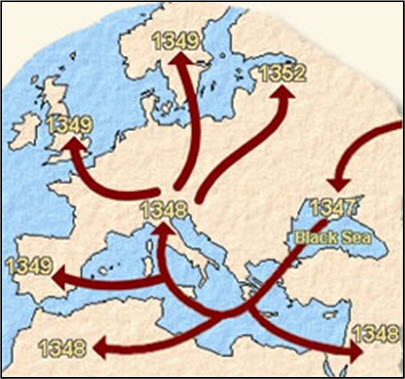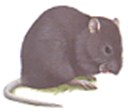


THE BLACK DEATH 1347 (E3)
xxxxxThe Black Death was a bubonic plague which spread across Europe from about 1347. Over the next four years about one third of Europe’s population perished. The disease was brought from the Far East, transmitted by fleas and carried by rats. Death occurred in two to three days, during which the skin turned a deep purple colour -
xxxxxThe Black Death was a vast epidemic of a bubonic plague that ravaged through Europe, arriving from China via the Middle East in about 1347. Froissart estimated that over the next four years about one third of Europe’s population was killed (some 75 million people) and this is generally accepted as a realistic figure. The source of the epidemic was the bacillus Pasteurella pestis. This was transmitted by fleas and carried to Europe on the black rats which infested ships coming from Asia.
 xxxxxThe plague, which was highly contagious, arrived at Weymouth on the south coast of England (then known as Melcombe Regis) in 1348, and quickly spread throughout the whole country. It had done its worst by the winter of the following year, but there were four further outbreaks throughout the remainder of the 14th century, and the plague remained epidemic in England until 1665. The outbreak in Bristol was particularly severe. The city was completely closed off, and it is estimated that nine-
xxxxxThe plague, which was highly contagious, arrived at Weymouth on the south coast of England (then known as Melcombe Regis) in 1348, and quickly spread throughout the whole country. It had done its worst by the winter of the following year, but there were four further outbreaks throughout the remainder of the 14th century, and the plague remained epidemic in England until 1665. The outbreak in Bristol was particularly severe. The city was completely closed off, and it is estimated that nine-
xxxxxDeath came comparatively quickly, in most cases just two or three days after the appearance of the first symptoms. There was a sudden onset of high fever and vomiting, and then the skin quickly turned a deep purple, due to respiratory failure. This discolouration gave the illness its common name, The Black Death, a term not used, in fact, until the early nineteenth century. There was no remedy as such, save keeping a safe distance away from the body and belongings of anyone infected.
xxxxxThe suffering, misery and desolation caused by this plague were on a vast scale. The whole of Europe was plunged into chaos. Many were convinced that Satan had taken over the control of the world, or that God was wreaking his vengeance on sinful man. Because of the severe shortage of food, bandits, sometimes in large groups, roamed the country stealing whatever food the y could find, and killing anyone who got in their way. In some places the strange idea was put about that if you had the plague and passed it on to someone else you would no longer be troubled by it yourself! One only needs to read the graphic opening passages of Boccaccio’s Decameron to appreciate the social and moral turmoil into which Europe was plunged.
y could find, and killing anyone who got in their way. In some places the strange idea was put about that if you had the plague and passed it on to someone else you would no longer be troubled by it yourself! One only needs to read the graphic opening passages of Boccaccio’s Decameron to appreciate the social and moral turmoil into which Europe was plunged.
 xxxxxThis was the worst natural disaster to befall the western world. Its most important long-
xxxxxThis was the worst natural disaster to befall the western world. Its most important long-
xxxxxRecovery of normal life was slow in coming. Indeed, as we shall see, in England, the Peasants’ Revolt of 1381 (R2), over thirty years later, can be seen as one of the long term effects of the Black Death, brought about by the social changes which followed in the wake of this tragic disaster. Furthermore, outbreaks of the plague, some of them serious and widespread, returned to haunt Europe and the Mediterranean region well into the 17th century.
Acknowledgements
Map (Europe): licensed under Creative Commons -
E3-


